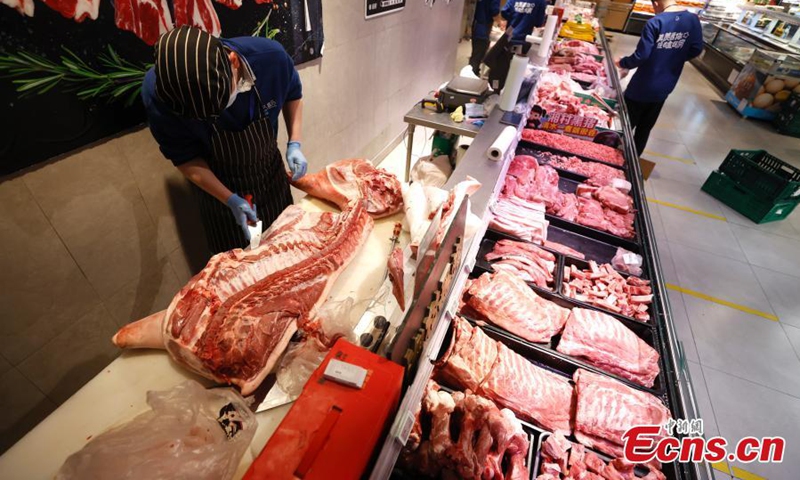China’s CPI rises a moderate 2.0% in 2022, in stark contrast to runaway inflation in other major economies

Pork products are seen at a Hema Fresh store in Chaoyang District, Beijing, April 26, 2022. (Photo: China News Service/Fu Tian)
China’s consumer price index (CPI), a main gauge of inflation, rose 2 percent year-on-year in 2022, marking a moderate growth, which is hard won and again proves the economy’s resilience despite runaway inflationary pressure faced by the US and other major economies.
In December, the CPI rose 1.8 percent, up from 1.6 percent in November, data from the National Bureau of Statistics (NBS) said on Thursday.
Food prices rose 4.8 percent in December compared with a year earlier, after an annual rise of 3.7 percent in November. Core CPI, which excludes volatile food and energy prices, edged up slightly from an annual rate of 0.6 percent in November to 0.7 percent last month.
In month-on-month terms, the CPI remained flat. Food prices reversed the 0.8-percent fall in November to rise 0.5 percent last month, raising the December CPI by about 0.09 percentage points.
Prices of fresh vegetables rose 7 percent while fruit up 4.7 percent from November, due to seasonal factors.
The price of pork, a staple meat in China, fell 8.7 percent in December from November due to increased market supply, according to the NBS.
Thanks to multiple measures conducted by local governments in managing COVID-19 and economic development, the market has benefitted from sufficient supply and stable prices, said Dong Lijuan, a statistician with the NBS.
The average CPI for the full year of 2022 came in at 2.0 percent, a little higher than 2021, is within the target range set by the government of around 3 percent.
The 2 percent inflation rate is well below major developed economies, with the US CPI rising 7.1 percent in November, and the rate for Eurozone at around 9 percent. Major emerging market economies like India, Brazil and South Africa also reported their inflation spiked between 7-10 percent (from January to November of 2022) , according to Wan Jinsong, director of the Price Department at the National Development and Reform Commission.
“The comparison is stark: we have stable prices compared with global levels,” Wan said.
Against the background of rising commodity prices, surging global inflation and growing pressure from imported inflation, China’s consumer prices have remained stable, which is hard won, Hu Qimu, deputy secretary general of digital-real economies integration forum 50, told the Global Times on Thursday.
It demonstrates the strong resilience of China’s economy, and effectiveness of its macro regulation, which have provided sufficient support for stabilizing the economy and ensuring living standards, Hu noted.
He estimated that the consumer price will maintain a moderate growth in 2023.
“With China’s optimized measures on COVID-19 prevention, the CPI is expected to edge up gradually, as consumption is picking up, such as private spending on tourism, accommodation and catering,” Hu said, adding that a moderate inflation rate increase indicates economic revival.
“We have full confidence and ability to maintain consumer goods prices at a stable level in 2023,” said Wan, the NDRC official, citing solid foundations including bumper grain harvest, reasonable hog production, sufficient supply of energy and other bulk commodities.
Thursday’s data also showed that China’s producer price index (PPI), which measures costs for goods at the factory gate, slid 0.7 percent in December.


